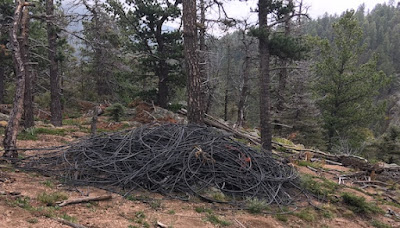 |
| Firs have been cut or limbed to allow more sunlight on the grow site. Drip irrigation lines fed the individual plants. Given the thin, poor mountain soil, heavy amounts of fertilizers are used. |
They reached their target area, a placed used by Mexican cartel* marijuana growers for several years, armed growers who had been arrested the previous October.
Finding no one re-using the site, they marked the faint footpath up from State Highway 165 with orange flagging and notified another agent waiting at the Forest Service work center in San Isabel.
 |
| BHA volunteer and trash. |
We all set to work — stuffing abandoned sleeping bags with trash, tearing down the crude buildings made of fir saplings and baling wire (kitchen, sleeping quarters, drying shed), and pulling armloads of black plastic pipe from under the forest duff and fallen trees.
With the plants gone, shelters gone, and the irrigation system gone, maybe this site would be less attractive in the future. Maybe the word would go back to Michoacán: Virgilio and Erik are doing time in an American prison. Maybe.
 |
| Interior of the kitchen area. White plastic buckets are camouflaged with paint. |
 |
| It takes a little time to free a tree from wraps of wire. |
• Diverting water illegally
• Cutting and injuring trees illegally
• Killing animals (deer, bear, etc.) illegally
• Potentially posing a threat to other public-lands visitors in order to hide their activities
I don't want any of that in your/my/our national forest, period full stop.
In 2012, I supported Amendment 64, which legalized recreational cannabis and limited home growing. I have joined the multitudes using CBD products for health support.
But passing Amendment 64 did indeed attract people who thought that they could grow outside the regulatory frameworks and somehow not be noticed.
Some were from inside the USA (mostly from Miami, curiously enough). They tended to buy or rent houses, stuff them with plants, and then be caught when (surprise) the utility company tipped off law enforcement that the split-level house at 428 Comanche Drive** was using fifteen times as much electricity as its neighbors. Others grew on private land, sometimes combining a legal operation with an additional illegal one.
 | |
| Some of the collected irrigation pipes and drip tubes. |
Compared to what legal growers produce, it seems like a lot of risky work for a lesser product, but there's the rub: some people don't want to pay legal retail prices. (California in particular, according to some, is keeping the black market alive by over-taxing legal cannabis.) Or they can sell it outside Colorado.
Finally, all the pipe and trash was collected in the most-open area, where a National Guard helicopters will be able to lift it out.
 |
| Helicopter lifting bundled trash from a different grow site (US Attorney's Office). |
** Fictional address.
***Some bright person should have (or has) created a GIS overlay to identify potential grow sites, just like wildlife habitats.
2 comments:
Amazingly, given the lack of water, there have been a lot of these operations out here in Greater Death Valley, including in the Park. We had a one a couple years ago in our watershed. Hiking students had noticed it independently, but later in the year the federales had a big ground game in motion. They asked our cowboys to leave the mountains for a while. Of course, they weren't as subtle as they hoped, and pretty much everyone in northern Inyo County knew what was up. By the time they acted, the grunts were long gone.
Heh. It's probably easier to be sneaky in the fir forests of the Wet Mountains than in Death Valley.
I asked one of the agents if they had used the state's multi-mission aircraft, which as great infra-red-sensing capabilities, to catch some of the "runners."
He said that they had, but it was not always as great as advertised.
I always wondered if you put on one of those cheapie Mylar ponchos at night, would it make you undetectable to forward-looking infra-red sensors.
Post a Comment